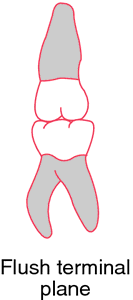occlusion
[ŏ-kloo´zhun]1. obstruction.
2. the trapping of a liquid or gas within cavities in a solid or on its surface.
3. the relation of the teeth of both jaws when in functional contact during activity of the mandible.
4. momentary complete closure of some area in the vocal tract, causing breathing to stop and pressure to accumulate.

Normal occlusion of the primary molars. From Darby and Walsh, 1994.
abnormal occlusion malocclusion.
central occlusion (centric occlusion) occlusion of the teeth when the mandible is in centric relation to the maxilla, with full occlusal surface contact of the upper and lower teeth in habitual occlusion.
coronary occlusion see coronary occlusion.
eccentric occlusion occlusion of the teeth when the lower jaw has moved from the centric position.
functional occlusion contact of the maxillary and mandibular teeth that provides the highest efficiency in the centric position and during all exclusive movements of the jaw that are essential to mastication without producing trauma.
Miller-Keane Encyclopedia and Dictionary of Medicine, Nursing, and Allied Health, Seventh Edition. © 2003 by Saunders, an imprint of Elsevier, Inc. All rights reserved.
ab·nor·mal oc·clu·sion
an arrangement of the teeth that is not considered to be within the normal range of variation.
Farlex Partner Medical Dictionary © Farlex 2012
ab·nor·mal oc·clu·sion
(ab-nōr'măl ŏ-klū'zhŭn)An arrangement of the teeth that is not considered to be within the normal range of variation.
Medical Dictionary for the Health Professions and Nursing © Farlex 2012
ab·nor·mal oc·clu·sion
(ab-nōr'măl ŏ-klū'zhŭn)Arrangement of teeth not considered to be within normal range of variation.
Synonym(s): abnormal occlusal relationship.
Synonym(s): abnormal occlusal relationship.
Medical Dictionary for the Dental Professions © Farlex 2012